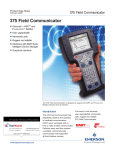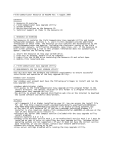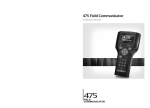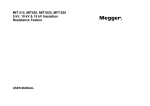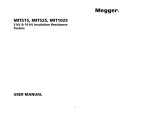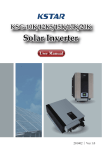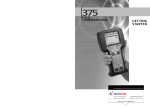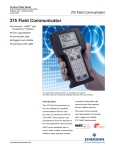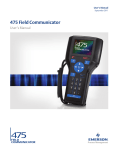Download 475 Field Communicator User`s Manual - Rev G English
Transcript
User’s Manual Rev G April 2012 475 Field Communicator User’s Manual USER’S MANUAL REV G April 2012 APPENDIX A 475 FIELD COMMUNICATOR REFERENCE DATA PROCESSOR AND MEMORY SPECIFICATIONS Microprocessor 80 MHz, max 133 MHz Hitachi® SH3 Memory Internal Flash 32 MB System Card 1 GB Secure Digital card or higher RAM 32 MB PHYSICAL SPECIFICATIONS Weight Approximately 1.65 lb (750 grams) includes battery Display 3.5” diagonal, 1/4 VGA (240 by 320 pixels) color touch screen Hard-coated surface Dimensions approximately 2.79” x 2.10” (71 mm x 53.3 mm) Keypad The keypad consists of the following: • A Power key to turn on and off the 475 or to put it in standby • A Backlight key to adjust the intensity of the light on the screen • Four navigation (arrow) keys to select, open, and back out of menu items • An Enter key to open menu items from the Field Communicator Main Menu or Settings menu, and select any highlighted button • A Tab key to move between buttons or fields on a window • A Function key that enables alternate functionality indicated by the blue text near the keys • Alphanumeric keys for entering data www.fieldcommunicator.com 92 USAGE SPECIFICATIONS Temperature limits +14°F to +122°F (-10°C to +50°C) 0% to 95%RH (non-condensing) for +32°F to +122°F (0°C to +50°C) Storage with batteries -4°F to 131°F (-20°C to +55°C) for less than 1 month Storage without batteries -4°F to +140°F (-20°C to +60°C) Enclosure rating IP51 (front) Shock Passes the 1-meter drop test onto concrete General guidelines • • • • Only use new, original parts. Do not recharge the battery in hazardous areas. Have repairs done by only qualified personnel. Charge or power using only the Field Communicator power supply/charger. CONNECTION SPECIFICATIONS HART and fieldbus communication terminals Three 4mm banana plugs (one common terminal to both HART and FOUNDATION fieldbus.) Connection types IrDA port ± 15 degrees recommended maximum angle between the 475 interface and adapter or PC. 18 in. recommended maximum distance between the 475 interface and adapter or PC. Bluetooth interface The Bluetooth Interface is a licensed option for the 475 Field Communicator. If your 475 is not licensed for Bluetooth, it does not have a Bluetooth radio.To use Bluetooth you need an approved adapter using the Windows Bluetooth software and drivers (stack) included with Windows XP Professional Service Pack 2 or 3, Windows Vista Business Service Pack 1, or Windows 7 Professional. The adapter should be plug-and-play if no other Bluetooth software or drivers were installed on your PC. The Easy Upgrade Utility cannot communicate with an adapter using third-party drivers. See www.fieldcommunicator.com or the readme file for more information. 30 feet (10 meters) recommended maximum distance between the 475 and a Bluetooth adapter attached to a PC. 93 Card reader Only supported card readers can be used with the System Card. Unsupported card readers may corrupt files. See the readme file on your Resource CD or DVD or www.fieldcommunicator.com for the list of supported card readers. The card reader can be used only with the Field Communicator Easy Upgrade Utility. BATTERY SPECIFICATIONS Battery type Two rechargeable Li-Ion cells, not serviceable Connection Green six-pin mini din (female) jack on the side of the battery Charge +50°F to +104°F (10°C to +40°C) Guidelines for the Li-Ion battery (Power Module) • Do not recharge the battery in hazardous areas. The power supply/charger is not IS-approved. • Charge or power using only the Field Communicator power supply/charger. • Recharge the battery frequently, preferably after each use. Limit full discharges, if possible. Lights Five lights (LEDs) on the side of the battery indicate the remaining level of battery charge. When you press and release the Charge Indicator button below these lights, the lights slowly illuminate. Each light indicates 20 percent of remaining charge, and the battery is fully charged when all of the lights are illuminated. See Figure 2-1 on page 2-12 for the location of the Charge Indicator button. Operating time 10 or more hours when the backlight is to highest setting 20 or more hours when the backlight is off 80 or more hours when using standby Storage -4°F to +131°F (-20°C to +55°C) less than one month Storage Guidelines for the Li-Ion Battery • Use a location at room temperature or cooler. Prolonged storage at higher temperatures can permanently reduce the charge capacity and performance. • Ensure the remaining charge is at or near mid-capacity. The charge will slowly drain during storage. Periodically recharge the battery during storage to ensure it does not drain to low levels. 94 POWER SUPPLY/CHARGER SPECIFICATIONS Connection Green six-pin mini din (male) plug Lights The power supply/charger has three colored lights that indicate the conditions below. Each light displays a different color. Voltage Color Condition Green The battery is fully charged. Flashing green The battery is nearly fully charged. Yellow The battery is charging. Flashing yellow The power supply/charger is not connected to the 475 Field Communicator. Flashing yellow and red The remaining charge in the battery is low. Red Charging cannot occur. Contact Technical Support for more information. 100-240 VAC, 50/60Hz, US/UK/EU connection types included Technical data Input voltage 100 - 240 VAC ±10% Input current 750 mA max. Standby current 20 mA max. Input fuse type TES 2A 250 V Timelag Output voltage 1 0 - 8.3 V Output current 1 1000 mA max. Output voltage 2 0 - 9.0 V Output current 2 1400 mA max. Output power rating 20 W Operating temperature 0°C - +40°C Storage temperature -20°C -+80°C Measurements [L x B x H] 112 mm x 51.5 mm x 29.5 mm Total Mass 240 g. Altitude Up to 2000m Pollution Degree 2 Installation Category 2 IEC Protection Class Double Insulation 95 ORDER INFORMATION Product Description Field Communicator (Note 1) Communication Protocol Code H HART F HART and FOUNDATION fieldbus (Note 2) Battery Type Code P Rechargeable Li-ion Power Module Power Supply/Charger Code 1 Power Supply/Charger Li-ion/NiMH US/UK/EU connection types included (Note 3) 9 Not Included (Note 4) Language Code E English D German J Japanese R Russian C Chinese F French P Portuguese Product Certifications Code KL ATEX, FM, CSA and IECEx Intrinsically Safe (includes FISCO as applicable) NA No Approval Easy Upgrade Code U Easy Upgrade Option (Note 5) 9 Not Included Included Options Code Graphics (Included at no charge) (Note 6) GM Device Configuration Management (Included at no charge) (Note 7) Code Bluetooth T Bluetooth Communications (Note 8) 9 No Bluetooth Communication (Note 8) Code Options Spare Battery A Spare Rechargeable Li-ion Power Module (Note 9) Enclosures S Protective Rubber Boot with Stand Typical HART Model Number: 475 H P 1 E KL U GMT Typical HART/Fieldbus Model Number: 475 F P 1 E KL U GMT Model 475 (1) Base Model 475 includes Field Communicator unit with color LCD display, System Card, Leadset with connectors, Carrying Case, Getting Started Guide, 475 Resource CD or DVD, stylus and straps. (2) This option requires that the Easy Upgrade option (code U) is specified. (3) To obtain an Australian Power Cord, order part number 00375-0003-0003. (4) This option should only be considered if the user already has a 375 or 475 Power Supply/Charger. If it is a 375 Power Supply/Charger, it must be the Li-Ion/NiMH version. 96 (5) The Easy Upgrade feature allows the user to add new System Application software and device descriptions (DDs) to the 475 for a period of 3 years. To upgrade without this feature, the System Card would have to be sent to a Service Center. (6) The Graphics Option enables a user to access enhanced graphical features when using the HART or FOUNDATION fieldbus application. (7) Device Configuration Management provides the capability to store up to 1000 configurations and print them using the Easy Upgrade Utility. (8) Bluetooth enables communication to a PC via the Bluetooth protocol. See list of countries with Bluetooth approval at www.fieldcommunicator.com. (9) A fully charged Li-Ion Power Module is capable of delivering power for 40 hours of typical field use. If requirements exceed this specification, a spare Power Module (code A) should be specified.







